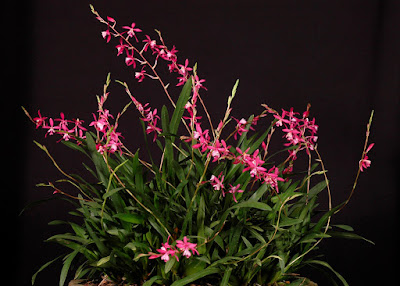Cochlioda rosea is native to Colombia, Ecuador and Peru. In southern Ecuador, these orchids grow in a relatively small area in very humid forests in the provinces of Zamora-Chimchipe and Loja...
Cochlioda rosea also called as The Rose Colored Cochlioda, Mesospinidium roseum, Odontoglossum roseum, Oncidium roseum, Oncidium roseoides, is a species of the genus Cochlioda. This species was described by George Bentham in 1883.
IDENTIFY COCHLIODA ROSEA
Cochlioda rosea is native to Colombia, Ecuador and Peru. In southern Ecuador, these orchids grow in a relatively small area in very humid forests in the provinces of Zamora-Chimchipe and Loja. In northern Peru, these plants are found in the Cajamarca and Amazonas departments. In Ecuador and Peru, they are usually found at heights of about 2000 m, but there are reports of encountering them at an altitude of 1500 m and even 2550 m. In Colombia, they grow in the mountains in the northern part of the Antioquia department at an altitude of 3000-3100 m.
It is a miniature to small sized, warm to cold growing epiphyte, which reaching 20 cm in height, with an ovate, compressed, ancipitous on the margin, 3-5 cm long pseudobulb enveloped basally by a few distichous sheaths with the uppermost being foliaceous and carrying a single, apical, coriaceous, strap-shaped, dark green, 5-20 cm long and 1.0-2.5 cm wide leaf that is conduplicate towards the base.
The Rose Colored Cochlioda blooms at most any time of the year on a basal, from the leaf sheaths, erect, 13 to 45 cm long, several to 20 flowered inflorescence with tubular, acuminate, inflated bracts and arising on a newly matured pseudobulb and carrying successive flowers. The star-shaped flowers are widely spread, dark pink-red and up to 2.0-3.8 cm in diameter. The narrow elliptical, blunt-tipped petals of both whorls have an upright dorsal petal and obliquely spread petals of both whorls. The lip is attached to the lower part of the spine and is directed forward from the wedge-shaped base, it has 3 distinct plots. The side plots are short, evidently ovoid near or slightly below the middle plot. The fairly long, longitudinal-oval center section curves gradually downwards and has a blunt tip. The thickening has 1-2 pairs of short, fleshy appendages around the base.
COCHLIODA ROSEA CARE AND CULTURE
Cultural information should only be used as a guide, and should be to be adapted to suit you. Your physical location; where you grow your plants, how much time you have to devote to their care, and many other factors, will need to be taken into account. Only then can you decide on the cultural methods that best suit you and your plants.
Light:
Temperature:
It is a plant with moderate thermal requirements. The average temperature of the day throughout the year is 21-23 ° C, and the night 10-12 ° C, which gives a daily difference of 9-13 ° C.
Humidity:
Substrate, growing media and repotting:
You can use any loose substrate. These plants can also be grown on rootstocks.
Watering:
Precipitation in natural habitat is probably the same throughout the year, with a slightly drier period in winter and early spring. Cultivated plants should be watered fairly abundantly during active growth, but excellent drainage is required and the roots must be dried quickly after watering.
Fertilizer:
During the active growth, the plants should be fertilized every week 1/4-1/2 of the recommended dose of fertilizer for orchids.
Rest period:
Cochlioda rosea need less water in the autumn, when new growths reach maturity and in winter, which is not a period of active growth, especially for the plants grown in the conditions of short and dark days at moderate latitudes, or when grown at temperatures lower than those given from habitats. The plants, however, should never dry up completely. Fertilization should be reduced or eliminated until new growths appear in the spring and regular watering is required.















COMMENTS